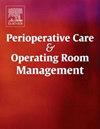Evaluation of patient privacy in perioperative care in the operating room of Be’sat hospital in Hamadan city
IF 1
Q2 Nursing
Perioperative Care and Operating Room Management
Pub Date : 2025-07-02
DOI:10.1016/j.pcorm.2025.100523
引用次数: 0
Abstract
Background
Adherence to a set of principles for patient rights, all defined in the form of professional ethics, is considered to be an essential aspect of health and safety issues, one of which is respecting patient privacy. Considering the special conditions of the operating room, maintaining privacy can improve the conditions before and after anesthesia of the patient. Accordingly, the present study aimed to examine the privacy of surgical patients admitted to the operating room of Be’sat Hospital in Hamedan.
Methods
This cross-sectional study was conducted on 200 patients undergoing surgery at Be’sat Hospital in Hamedan in 2022. In order to evaluate the privacy of the patient, a researcher-made checklist was used, which included two sections "demographic information and evaluation of the patient's privacy". The privacy measurement section consisted of 36 items based on a two-choice response (Yes, No), and evaluated the patient's privacy in three stages: admission and transfer of the patient to the operating room, during surgery, and after the operation. Data analysis was carried out using descriptive statistics, frequency distribution, mean and standard deviation, Mann-Whitney, Kruskal-Wallis, and Spearman correlation coefficient in SPSS ver. 22.
Results
Most of the participants in this study were men (60 %), married (80 %), and aged 18–39 (36 %). The lowest score was observed upon admission and transfer to the operating room while the highest score was reported during surgery (in the operating room). A significant association was observed between patient privacy in different stages with gender, marriage, employment status, and type of surgical service (P < 0.05).
Conclusions
The results of the present study revealed that the privacy of the operating room patients is high. This shows that maintaining the privacy of patients from the perspective of operating room personnel is of particular importance. If suitable solutions are provided by operating room and hospital managers to identify existing problems, patient satisfaction and the quality-of-care services can be improved.
哈马丹市贝萨特医院手术室围手术期患者隐私评价
遵守一套以职业道德的形式界定的病人权利原则被认为是健康和安全问题的一个重要方面,其中之一就是尊重病人隐私。考虑到手术室的特殊情况,保持隐私可以改善患者麻醉前后的情况。因此,本研究旨在调查哈马丹Be 'sat医院手术室住院手术患者的隐私。方法对2022年在哈马丹市贝萨特医院接受手术治疗的200例患者进行横断面研究。为了评估患者的隐私,使用了研究人员制作的检查表,其中包括“人口统计信息和患者隐私评估”两个部分。隐私测量部分包括36个项目,基于两种选择的回答(是,否),并在患者入院和转移到手术室,手术期间和手术后三个阶段评估患者的隐私。采用SPSS ver中的描述性统计、频率分布、均值和标准差、Mann-Whitney、Kruskal-Wallis和Spearman相关系数进行数据分析。22.结果本研究的大多数参与者为男性(60%),已婚(80%),年龄在18-39岁(36%)。住院及转手术室时评分最低,手术(手术室)时评分最高。不同阶段患者隐私与性别、婚姻、就业状况和手术服务类型之间存在显著关联(P <;0.05)。结论本研究结果显示,手术室患者的隐私性较高。这表明,从手术室人员的角度来看,维护患者的隐私是特别重要的。如果手术室和医院管理人员提供合适的解决方案,以确定存在的问题,患者满意度和护理服务质量可以得到改善。
本文章由计算机程序翻译,如有差异,请以英文原文为准。
求助全文
约1分钟内获得全文
求助全文
来源期刊

Perioperative Care and Operating Room Management
Nursing-Medical and Surgical Nursing
CiteScore
1.30
自引率
0.00%
发文量
52
审稿时长
56 days
期刊介绍:
The objective of this new online journal is to serve as a multidisciplinary, peer-reviewed source of information related to the administrative, economic, operational, safety, and quality aspects of the ambulatory and in-patient operating room and interventional procedural processes. The journal will provide high-quality information and research findings on operational and system-based approaches to ensure safe, coordinated, and high-value periprocedural care. With the current focus on value in health care it is essential that there is a venue for researchers to publish articles on quality improvement process initiatives, process flow modeling, information management, efficient design, cost improvement, use of novel technologies, and management.
 求助内容:
求助内容: 应助结果提醒方式:
应助结果提醒方式:


